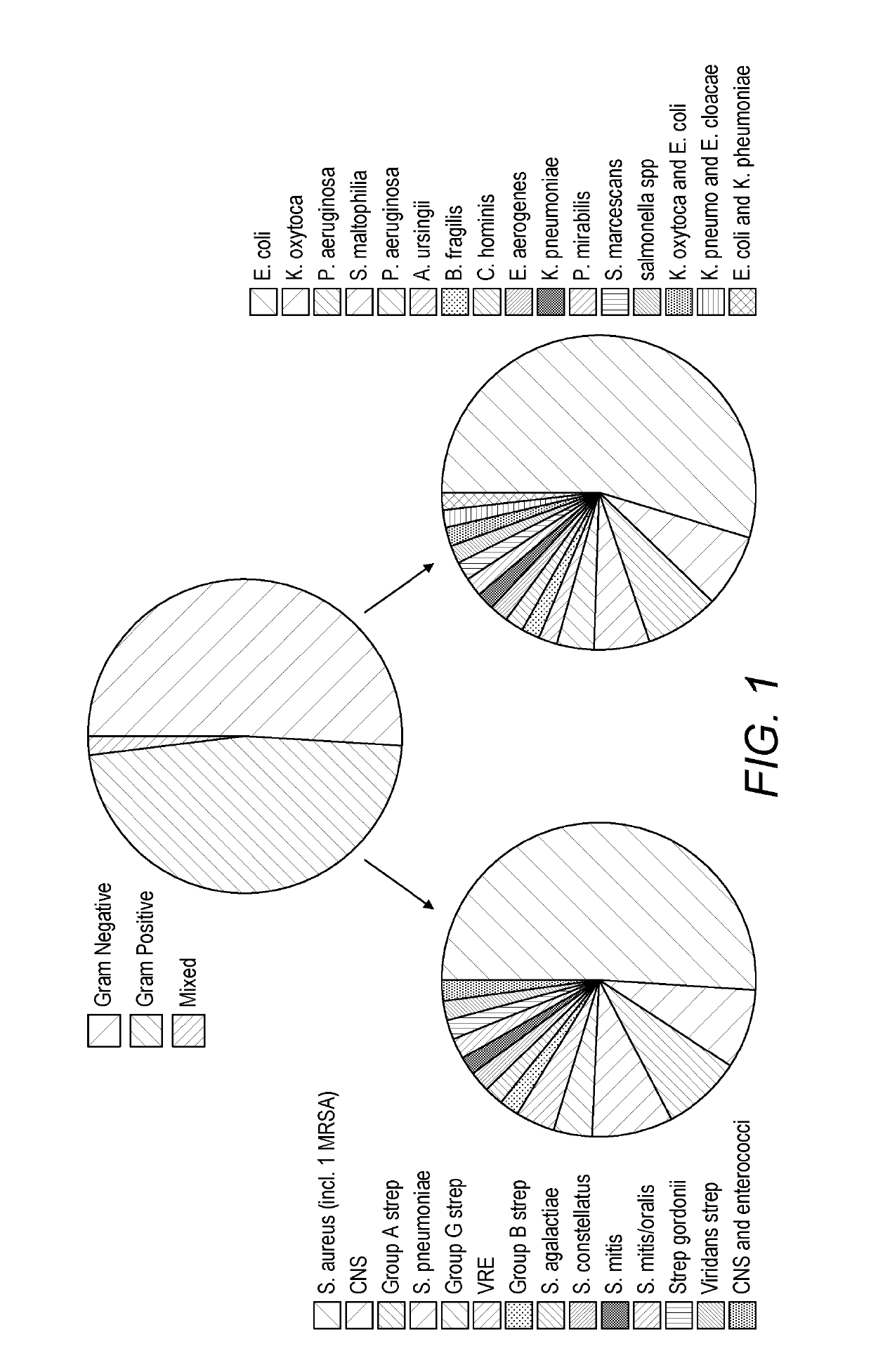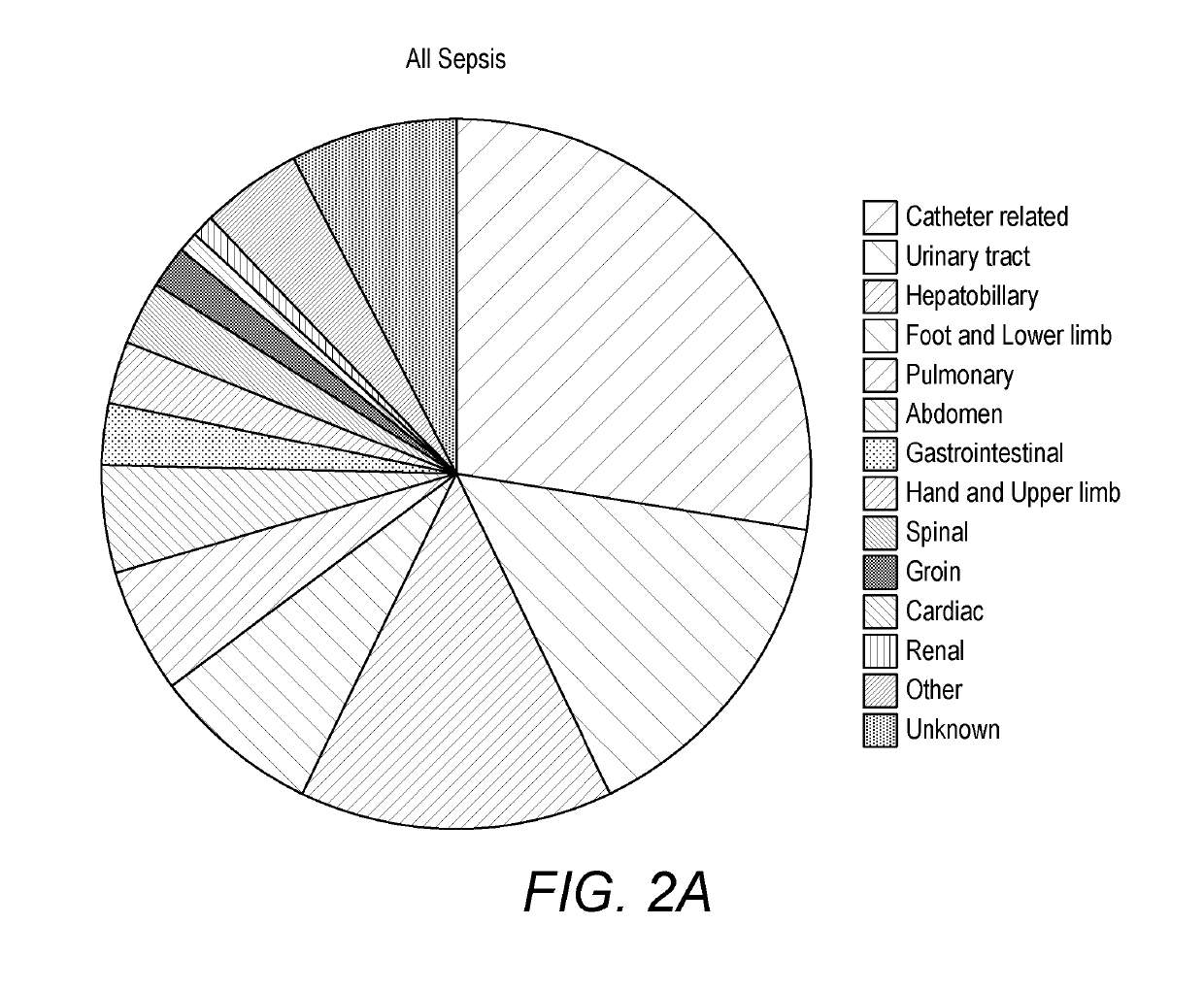Detecting sepsis
a sepsis and marker technology, applied in the field of identifying markers, can solve the problems of inability to find a specific marker that is reproducibly quantifiable in all septic patients, limited ability to distinguish between sepsis and systemic inflammatory response due to non-infectious, and inability to detect sepsis
- Summary
- Abstract
- Description
- Claims
- Application Information
AI Technical Summary
Benefits of technology
Problems solved by technology
Method used
Image
Examples
example 1
on CRP for sepsis diagnosis
SUMMARY
Background
[0415]Although many new biomarkers for sepsis diagnosis have been investigated, to be useful in clinical practice, and to improve sensitivity and specificity it may be necessary to combine them with traditional markers, particularly C-reactive protein (CRP). This study compared the diagnostic accuracy of CRP used alone and in combination with selected complementary markers for the diagnosis of sepsis.
[0416]Methods
[0417]One hundred and two patients diagnosed with sepsis based on strict clinical criteria including positive blood cultures (51 with Gram-positive, 49 Gram-negative and 2 mixed Gram-positive and Gram-negative microorganisms) were compared to 102 patients with no evidence of sepsis. Serum levels were measured for CRP and procalcitonin (PCT), as well as seven selected potential markers. These comprised: two inflammatory cytokines, interleukin-6 (IL-6) and tumour necrosis factor alpha (TNFα); the vascular marker soluble intercellula...
example 2
and Results
[0453]Clinical samples made available from a clinical study performed by University Hospital Birmingham (UHB) were tested. They were categorised according to the time of sample:
[0454]A=admission / onset of symptoms
[0455]B=time blood culture (BC) taken *values in bold represent (Number of A / B samples=44)
[0456]C=time BC positive=32 samples
[0457]D=time of consent (large volume)=88 samples
[0458]E=last sample prior to discharge=18 samples
[0459]Controls=102 samples
[0460]They were tested using the following assays:
MarkerAssay TypeFormatSupplierCRPELISASandwichR&D SystemsCRPLateral flowSandwichMologicsICAM1ELISASandwichR&D SystemssICAM1Lateral flowSandwichMologicCRP / sICAM1 DuplexLateral flowSandwichMologicIL-6ELISASandwichR&D SystemsIL-6Lateral flowSandwichMologicPLA2ELISASandwichMologicPLA2Lateral flowSandwichMologicIL-6 / PLA2 DuplexLateral flowSandwichMologicA1ATELISASandwichMologicA1ATLateral flowSandwichMologicTNFαELISASandwichR&D SystemsTNFαLateral flowSandwichMologicCCL23ELISA...
example 3
y and Results
[0470]910 samples were received and tested on 10 assays at Mologic. The samples were collected from patients admitted for elective surgery and daily samples were collected for up to 7 days post-surgery. The patients were stratified into 3 different groups:
[0471]1. Control group (n=70)—those that recovered with no SIRS symptoms
[0472]2. SIRS group (n=66)—those that presented with SIRS symptoms within the 7 days
[0473]3. Sepsis group (n=70)—those that developed sepsis within the 7 days
[0474]Some samples were missing where patients refused consent or the research nurses failed to get good venous access, and as for the sepsis group, focus was on days −1, −2 and −3 pre-sepsis diagnosis.
[0475]Differentiation Between SIRS and Sepsis
[0476]Samples were grouped according to DSTL defined SIRS diagnosis based on heart rate, respiratory rate, WCC and temperature and other parameters. The first step was to analyse all samples from patients with sepsis (with SIRS) (n=117) and SIRS (n=17...
PUM
| Property | Measurement | Unit |
|---|---|---|
| concentration | aaaaa | aaaaa |
| concentration | aaaaa | aaaaa |
| concentration | aaaaa | aaaaa |
Abstract
Description
Claims
Application Information
 Login to View More
Login to View More - R&D
- Intellectual Property
- Life Sciences
- Materials
- Tech Scout
- Unparalleled Data Quality
- Higher Quality Content
- 60% Fewer Hallucinations
Browse by: Latest US Patents, China's latest patents, Technical Efficacy Thesaurus, Application Domain, Technology Topic, Popular Technical Reports.
© 2025 PatSnap. All rights reserved.Legal|Privacy policy|Modern Slavery Act Transparency Statement|Sitemap|About US| Contact US: help@patsnap.com



